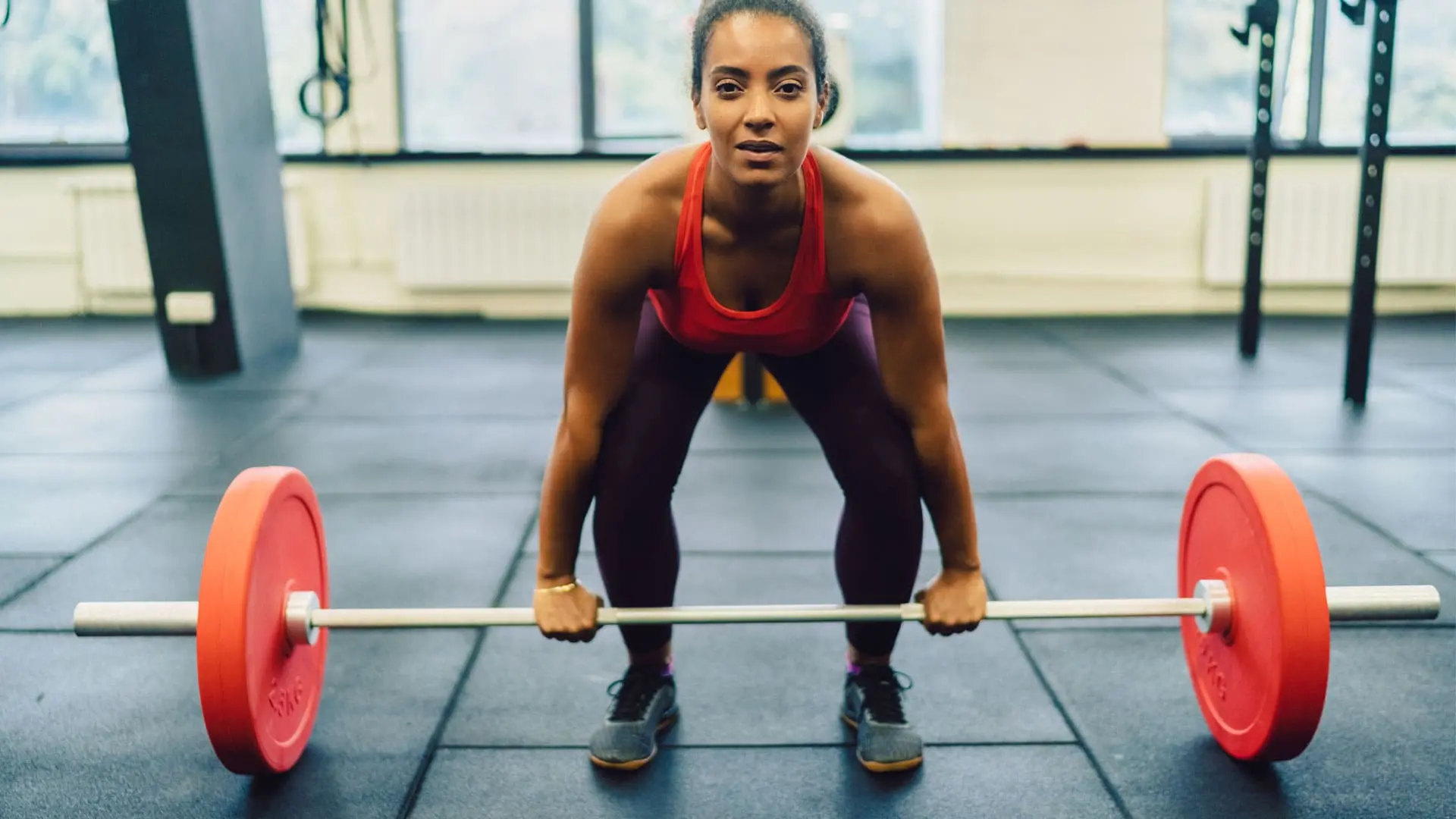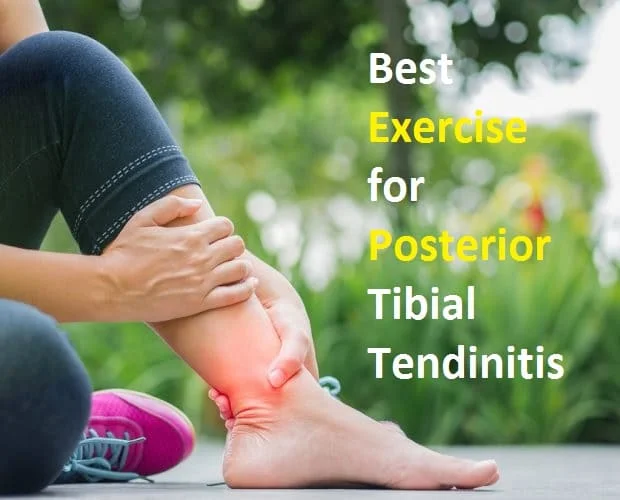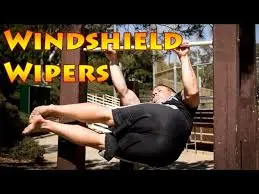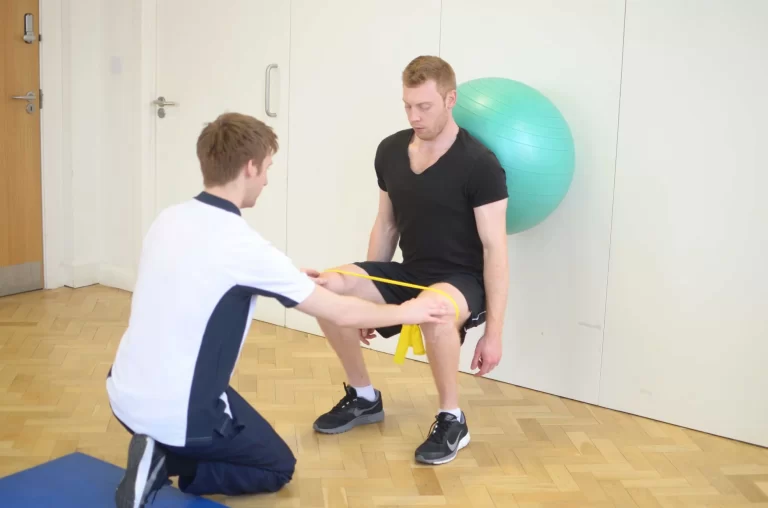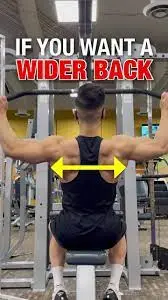What Muscles Do Deadlifts Workout?
Deadlifts are a compound exercise that engages multiple muscle groups, making them a highly effective full-body workout.
Introduction
A popular opinion is that deadlifts are the definition of compound movements And with good cause. The deadlift is a fairly simple movement with a lot of advantages. It improves posture, builds overall strength, and simultaneously engages multiple muscle groups. In this blog, we look in-depth at which muscle deadlifts work, exploring the primary and secondary muscle groups.
Deadlifts are a great addition to any weekly workout regimen if you prefer lifting heavy weights. Deadlifts help you quickly acquire strength and improve your fitness level since they train numerous muscle groups simultaneously. Exercise-wise, deadlifts help build the muscles needed to carry out daily actions like bending down to get groceries or lifting your children or animals.
The hip-dominant deadlift exercises the back, glutes, hamstrings, core, and trapezius muscles. Deadlifts are a great exercise to include in a workout to target specific muscle areas or increase general strength and athleticism because they train many different muscle groups. One can perform deadlifts with different weights, barbells, and ranges of repetitions. Deadlifts are a safe and efficient workout for improving muscle and strength.
Out of all the traditional exercises, deadlifts have some of the highest functional carryover. The power and mechanics developed through deadlifting “transfers into our day-to-day lives of being able to pick stuff up off the ground and do so efficiently and safely.”Because deadlifting works so many different muscles at once, it not only improves our movement patterns but is also efficient exercise to corporate into our routines. The majority of the body’s muscles are worked during this motion.
Exercises like deadlifts are difficult to get the hang of. If you are a gym member, consult a trainer or other fitness specialist. They can illustrate the proper method. To ensure you are doing the exercise correctly, have the trainer observe you. You will pick up the barbell with a flat back and push back with your hips to complete a deadlift. Because they are a useful exercise for simultaneously strengthening several major muscular groups, deadlifts may be advantageous.
Major muscular groups used in deadlifts:
A complex exercise that engages multiple muscular groups is the deadlift. When it comes to working out several different muscle groups, deadlifts are an extremely effective exercise. Exercises like the deadlift help improve posture and reduce the risk of injury from daily tasks. Exercises that focus solely on one muscle area, like leg extensions and curls for the quadriceps and hamstrings, are less likely to stimulate general muscular growth and a well-rounded physique than deadlifts. They can promote fat reduction and raise energy expenditure because they use a lot of muscles.
Here are the many muscles used in deadlifts and how they function,
Primary Muscles Worked:
Erector Spinae (Lower Back):
- The lower back’s erector spine is in charge of spinal extension and keeping the body erect while lifting.
- A collection of muscles called the erector spine extends from the base of the skull to the pelvis down the spine.
- They support the spine, which is essential for upholding proper posture.
- They assist in stabilizing the spine and maintaining its locked position throughout the deadlift.
Gluteus Maximus (Buttocks):
- The main muscle that extends the hip during the movement.
- The big muscles in the buttocks are called the glutes, or gluteal muscles.
- For hip abduction, hip extension, and the hip portion of the deadlift, are essential rotations from the outside in.
Quadriceps (Front Thighs):
- Assists in knee extension during the lift’s initial phase.
- You can push the weight off the floor with the aid of your quadriceps.
- When performing deadlifts, remember to properly engage your quadriceps by “pushing your feet through the floor.
- The quadriceps are a group of four muscles located near the front of the leg. They are essential for knee extension. (straightening the knee bending).
- The quadriceps help with knee extension, which is sometimes referred to as leg extension, which helps with the deadlift motor.
- Since the knee is only slightly bent, the quads need to be in a firm position, just like the glutes.
Hamstrings (Back Thighs):
- Helps with knee flexion and hip extension during the lift.
- Your pelvis can be driven forward by your hamstrings. They become very active after the bar is a few feet off from the floor,”.
- During the lockout, the hammies assist the glutes in hip extension. To raise the hips to the bar, the hamstrings are pulled more as the knees straighten.
Adductors (Inner Thighs):
- Helps to keep the thighs and hips stable while lifting.
- Your adductors help move the pelvis forward as well.
- You will be more powerful if you can get your hips “over the bar” more quickly.
- The gastrocnemius is a muscle in the rear of the lower leg that is also referred to as the calf muscle.
- Its primary function is plantarflexion, or lowering the foot.
- It also contributes to knee flexion, which is the shortening of the knee during a deadlift.
Secondary Muscles Worked:
Latissimus Dorsi (Lats):
- The lats, or latissimus dorsi, are used to stabilize the upper back.
- Additionally, the bar stays close to your body by tracking down your shins thanks to your lats.
- The lats, in addition to the rhomboids, stop the bar from tracking forward in front of your toes, which can cause damage.
Trapezius (Upper Back):
- The upper back and scapula are stabilized by the trapezius muscle.
- A strong deadlift locko necessitates strong traps.
Rhomboids (Upper Back):
- Support and stabilize the scapula.
- Before getting off the ground, try to “put your shoulder blades in your back pockets.”
- This signals the rhomboids and (lower) trapezius to contract and engage.
Abdominals (Core):
- The purpose of the abdominals (core) is to anchor the spine and stop any movement that can cause pain, strain, or injury.
Benefits of deadlift:
A complex exercise that simultaneously trains huge muscle groups and several joints is the deadlift. This indicates that it provides several advantages, such as:
- Muscle strength and size: The deadlift is a good workout. A reliable resource for developing upper and lower body muscles. It can therefore aid in enhancing general strength and athleticism. A person’s metabolism might also rise with an increase in muscle mass.
- Bone density: By applying a proper amount of stress to the bones, the deadlift can promote bone density and lower the chance of injury. For bone health, resistance training—which includes deadlifts—is very crucial, especially as people get older.
- Posture: The deadlift trains the shoulder and back muscles to cooperate. This may help with posture. The collection of muscles that comprise your back is called the posterior chain. It is in charge of basic strength, core protection, posture, and spinal alignment.
- Mental health: Strength training has been demonstrated to enhance mental well-being. dependable source by lowering tension and fear.
- Accessibility: People of all fitness levels can perform the deadlift because exercise may be done with a variety of weights. Deadlifting can be done at home with weights, resistance bands, or homemade weights; one does not need to go to a gym for this exercise like bottles of water.
- Effective Training: The deadlift stimulates a wide range of muscles at once, as evidenced by the lengthy list above. It’s a multi-joint compound lift, which is the gold standard. You’ll work multiple muscles at once, making the most of your gym time. Furthermore, because of the quantity of muscle recruitment, you’ll be able to load up hefty weight, which will aid in improving strength.
- Train Functional Movement: The deadlift simulates an action that we all do daily: pulling objects up off the ground or a low surface. if you’ve never stepped foot on a lifting platform, if you’ve ever hinged to grab something from the floor, you’ve done a deadlift (though perhaps not a safe one). Training deadlifts help us gain strength and good biomechanics with hip hinging, allowing us to securely take up items located low on the body.
The way to do Deadlift Properly:
The more muscles used, the more difficult the lift; for this reason, if you’re not experienced, the deadlift can be a little confusing. That implies that if done improperly, it might also swiftly result in harm. To guarantee that your deadlifting remains flawless, adhere to this guide.
Way to carry out It;
- Placing your feet exactly beneath the barbell, take a step toward it.
- To grip onto the barbell, lower your hips.
- When you do, make sure your back remains flat and your hips remain below your shoulders.
- Squeeze your shoulder blades together as if you were attempting to hold a pencil between them before raising the weight off the ground.
- Take the slack out of the bar by pulling it slightly to assist with this.
- Right before you lift, take a deep breath and brace your core.
- Make sure your knees and hips expand simultaneously as you perform.
- Ascend to a standing posture in which your hips are squarely beneath your shoulders.
- As you return the weight to the floor, maintain control over it
- Next, unwind.
- Practice from five to ten repetitions of this exercise each day.
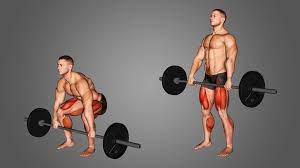
Variations on Deadlift:
There are various techniques to perform the deadlift to work different muscle groups. It’s critical to vary your deadlift technique to maintain a well-rounded training regimen. Your level of fitness determines how much weight to use. Only once you have perfected the proper form can you add more weight.
Among the variations are;
Romanian deadlift:
This popular version works the majority of the posterior muscles and the hamstrings. Throughout the entire exercise, a person maintains a somewhat straight leg position as opposed to bending their knees.
- Grip the bar with your palms facing down, starting at hip level.
- Maintain a straight spine and a backward posture.
- This movement may cause a little arch in your back.
- As you drop the bar toward your feet, maintain its proximity to your torso and press your hips back throughout the movement.
- Either your legs should be straight or your knees should be slightly bent.
- The movement in your hamstrings should be felt.
- To stand tall, push your hips forward while maintaining the barbell in front of your thighs.
- Next, unwind.
- Practice from five to ten repetitions of this exercise each day.
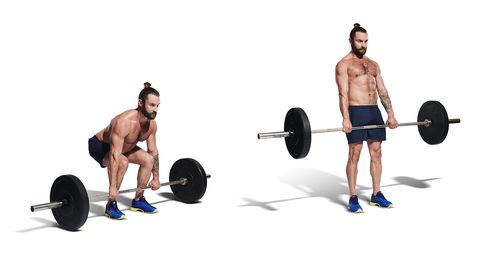
Dumbbell deadlift using one arm and one leg:
This workout strengthens the core, balance, and stability.
- Carrying a dumbbell in the same hand as your standing leg, stand on one leg.
- Bend your standing knee slightly, press your hips back, and be ready to lower your torso toward the floor while maintaining a straight arm.
- It is the appropriate place for you to start.
- As your back leg rises behind you, lower your torso toward the floor.
- Keep the dumbbell close to your shin by pushing your chest out and lowering it as far as you can without rounding your back.
- Squeeze your glutes at the beginning position, pause, and repeat the motion.
- Next, unwind.
- Practice from five to ten repetitions of this exercise each day.
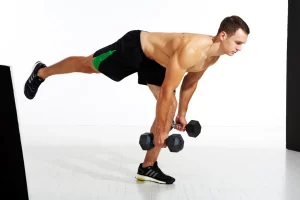
Cable Romanian deadlift:
If someone is uncoordinated and unbalanced, this is a good alternative. Instead of a barbell or dumbbell, it employs cables. It is the same technique as the Romanian deadlift, but instead of using weights, cables provide resistance.
Try the cable deadlift if you’re a beginner and don’t want to use weight. Make use of a cable machine that has a medium resistance cable at a low height.
- Place both hands on a rope and place your feet shoulder-width apart.
- Extend your knees gently and lean your hips forward.
- Slowly bring your hands up to the top of your feet by allowing the cable resistance to do so.
- Stretch out from the hips and take a tall stance to return to the beginning position.
- Next, unwind.
- Practice from five to ten repetitions of this exercise each day.
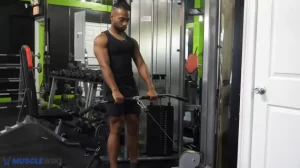
Sumo Deadlift:
This variation is beginner-friendly and allows you to have control over the weight throughout the entire movement.
- Take a wide stance in front of a weighted barbell.
- With your hands on the bar inside your feet, elbows just inside your knees, toes pointing slightly out, and arms inside your legs, pose yourself.
- Maintain a flat back, shoulders over the bar, and shins perpendicular to the floor.
- Your torso should be upright, your outer hip muscles firm and engaged, and your knees broad and pushed out.
- Activate your glutes, lower back, and legs while bracing your core.
- Grip the bar, extend your quadriceps, and lower and raise your shoulder blades.
- Please take a deep breath, press your legs into the ground, and pull up on the bar without lifting it off the floor.
- Pull the bar along your legs while maintaining a high chest and lower hips.
- At the top, lock your hips and knees while contracting your glutes.
- Slowly reverse the motion while maintaining a close grasp of the bar.
- Next, unwind.
- Practice from five to ten repetitions of this exercise each day.
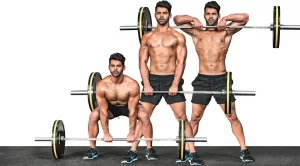
Hex Bar Deadlift:
You’ll need something called a “hex bar” or a trap bar for this kind of deadlift. The hex bar has handles on either side and is formed like a huge hexagon. Compared to a straight barbell, hex bar deadlifts engage less back muscle and more leg muscle.
- Step right, keeping your feet hip-width apart, right in the center of the hexagon bar.
- Once hands can grasp handles with straight arms, push back butt and bend at the knees.
- Extrude your chest while bringing your shoulders down.
- Then, to stand, straighten your knees while maintaining a flat back and locked out arms.
- Hinge at the hips and bend the knees while maintaining a flat back to gently descend the bar back to its starting position.
- Next, unwind.
- Practice from five to ten repetitions of this exercise each day.
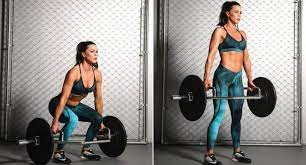
When working out, keep these important safety precautions in mind:
- Refrain from doing stuff that brings about you discomfort.
- Take your time when working out.
- It is not required to move quickly.
- The appropriate tools must be used.
- Put on cozy shoes and loose-fitting clothing.
- Before exercising, make sure you warm up appropriately.
- If you have severe pain when exercising, stop.
- If you experience any pain or discomfort when exercising, you should stop immediately.
- Increase the number of repetitions and duration of your workouts gradually to prevent overtraining and muscle soreness.
- Remember the proper form when doing out because the improper form can lead to injury and not produce the intended results.
- It’s important to give yourself ample time off between workouts so that your muscles remain healthy.
- Drink enough water to keep hydrated and sustain optimal muscular function.
How many deadlifts should you do?
- The amount of weight you’re utilizing determines how many deadlifts you should perform.
- To reap the benefits of deadlifts, you’ll need to lift a lot of weight if your fitness level is advanced.
- If so, then do one to six deadlifts in a set of three to five, with a break in between.
- Perform five to eight deadlifts per set if you are new to the exercise and are concentrating on perfecting your form with a smaller weight. Ascend to three or five sets.
- Never forget that the right form always matters more than the number of sets.
- Don’t perform deadlifts more than twice or three times a week to give your muscles enough time to recover between sets.
Summary
Exercises such as deadlifts are compound movements that work the muscles of the hamstrings, glutes, and core simultaneously. A compound exercise that works the legs, shoulders, and back muscles is the deadlift. When done properly, it can assist in increasing muscular growth and strength while also enhancing posture.
It is suitable for people of all fitness levels and can be customized to target different muscle areas. For instance, one can eliminate the weight or use less weight to make deadlifts easier. The exercise works the quads, core, and upper back muscles in addition to the posterior chain, which includes the glutes, hamstrings, and erector spinae. Including the deadlift in your training program will help you get more fit overall, perform better on the field, and maintain better posture and spinal health.
To maximize the effects and prevent injury, the exercise must be done with the correct form and technique. The deadlift is an excellent tool for developing stability and functional strength. It’s a crucial workout for everyone trying to increase their level of fitness and general physical functioning.
FAQs
Your erector spinae and lower back, your glutes, and your hamstrings are the three major muscular groups that the deadlift targets. Your hamstrings are one of your main movers during the deadlift, thus they will be exerting the most effort.
Exercises that engage your full body, like squats and deadlifts, differ in how they target the lower body. In contrast to deadlifts, which require you to bend at the waist and drive your hips back as you raise the barbell off the ground, squats need you to bend at the hip and knee joints.
One of the most frequent drawbacks of deadlifting is injury and strain to the muscles. Poor posture and technique, as well as lifting weights that are too heavy, can lead to increased tension in the hips and lower back, increasing the risk of injury. It’s usually preferable to lift with a spotter.
The idea behind a deadlift is straightforward; the challenge is in maintaining good form, and technique, and lifting the right amount of weight for your level of physical strength.
Deadlifts are an excellent way to increase general strength and power, particularly in the back, glutes, and leg muscles. They can also strengthen grips, aid in preventing injuries, and enhance posture.
Each of them. The posterior chain, which includes the muscles in the back and legs, from the hamstrings to the lats, is fully worked during a deadlift. Additionally, they target the anterior chain, which includes the core and quadriceps. All things considered, they are a fantastic compound workout for developing general strength.
Indeed, deadlifts aid in the development of back, glute, and leg muscles. They give your body a solid foundation, preventing muscular imbalances and enhancing the other lifts you perform.
Yes, including deadlifts in a bodybuilder’s training regimen can be beneficial. One excellent compound exercise that can help increase muscular growth and general strength is the deadlift.
The Greatest Workout for Deadlifts
The Romanian deadlift is a great place to start for novices. The trap or hex bar deadlift is the next step. You may learn the perfect deadlift form with the bar’s structure and high handles, which reduce motion demands and injury risk.
85–100% of body weight for a beginner.
Intermediate: between 115 to 135% of total weight.
Proficient: 140–165% of total body weight.
Elite: 175–200% of total body mass
You will add more lean muscular mass to your arms, shoulders, back, legs, and program if you incorporate deadlifts into your exercise regimen and perform them properly. Additionally, you’ll gain stronger core muscles. Greater power and endurance as well as improved sports performance are correlated with larger muscles and stronger cores.
Advantages of deadlifting
This indicates that it has some advantages, such as Size and strength of muscles: One of the best exercises for developing upper and lower body muscles is the deadlift. It can therefore aid in enhancing general strength and athleticism. A person’s metabolism might rise in tandem with an increase in muscle mass.
The entire body tone is altered by deadlifting. Given how many muscles the deadlift can activate, performing this exercise frequently can help you develop and expand these muscle groups, which will increase your muscle mass and definition—a highly desired outcome of strength training.
It is sufficient to perform deadlift training once a week with complete attention to deadlifts to improve your health, mobility, muscular growth, and fat loss. This kind of training needs to be carried out with a solid strategy with the goal of long-term training. It’s not a wise idea to train with deadlifts every day. It is not beneficial.
keeping the core tight, and pushing down through the legs and feet to increase leg muscle activity are three crucial components of a good deadlift technique. Throughout all of your deadlift sessions, pay close attention to these three points, especially before advancing to heavier loads.
The lower body, especially the hamstrings, glutes, and lower back, is the main goal of deadlifts. To stabilize the weight, they also use traps, lats, and rhomboids, among other upper body muscles.
Your body’s overall muscle development is one of the biggest and most noticeable advantages of deadlifting. The deadlift is a multi-joint, compound exercise that works a wide variety of muscle groups, such as the quads, upper back, hamstrings, lower back, and glutes.
Lifting too much weight: Deadlifting puts a lot of strain on the low back and hips. An imbalance in the distribution of load between these areas, often leading to an increase in load at the lumbar spine and an increased risk of injury, can be caused by poor technique or excessive weight.
promoting the burning of fat and weight loss.
Deadlifts are an excellent way to burn calories. This compound movement’s high energy expenditure and muscle-building benefits help people lose fat and develop a leaner body. Additionally, it raises metabolic rate, which increases calorie expenditure while at rest.
The deadlift is undeniably a tough workout. One fact is that it is quite effective, which is why most people use it into their weight training routine. Even if they struggle or despise harsh exercise, they are willing to endure some discomfort in order to get in shape.
Furthermore, deadlift workouts provide long-term benefits. Because muscle tissue is more metabolically active than fat tissue and burns more calories, having more muscle increases your resting energy expenditure.
References:
- Mph, Z. S. Oct. 27, 2022. Important information regarding deadlifting. What Does a Deadlift Affect Muscles? via Medical News Today Reference inside text: (Mph, 2022)
- Muscle & Fitness One-Arm One-Leg Deadlift Exercise. (November 6, 2014). Strength and Health. One-arm, one-leg deadlift: https://www.muscleandfitness.com/exercise/workouts/leg-exercises/ In-text Citation: (Muscle & Fitness, 2014) One-Arm One-Leg Deadlift
- Chertoff, J. (November 13, 2019). Which Muscles Are Used in Deadlifts? Strengthening Exercises for the Deadlift: How to Work Your Muscles Reference within the text: Chertoff, 2019
- CSCS, C. R. Sept. 27, 2023. These Are Every Muscle Used in a Deadlift. Male Health. In-text Citation: (CSCS, 2023) https://www.menshealth.com/fitness/a44715137/what-muscles-do-deadlifts-work/
- Chertoff, J. (December 11, 2023). Which Muscles Are Used in Deadlifts? Personal Trainers were Asked. Byrdie. https://www.byrdie.com/what-muscles-are-necessary-for-deadlifts-5179572 Citation within the text: (Chertoff, 2023)
- Kassel, G. Sept. 7, 2022. The Whole Manual on Deadlifts. Types of deadlifts: https://www.shape.com/fitness/workouts/strength-training Reference within the text: Kasel, 2022
- November 9, 2023: Cpt, R. M. B. The One Exercise You Need for a Strong Body. Form. What Muscles Are Needed for Deadlifts? 8356383 Citation inside text: (Cpt, 2023)
- Wilkinson, H. ( October 30, 2023). Which muscles are used in deadlifts? | BulkTM. The deadlift muscles worked may be found at https://www.bulk.com/uk/the-core/. Reference inside text: (Wilkinson, 2023)
- Image 4, MuscleWiki – Make exercise easier. (n.d.). Greek deadlift cable bar: https://musclewiki.com/cables/male/lowerback/ In-text Citation: (Simplify Your Workout with MuscleWiki, n.d.)

